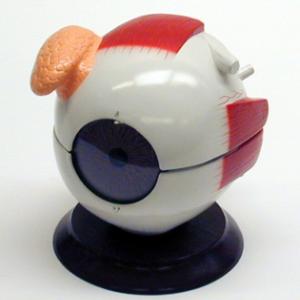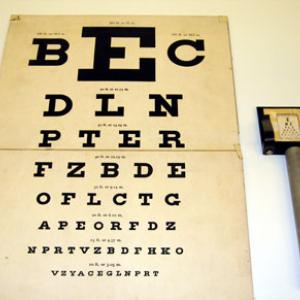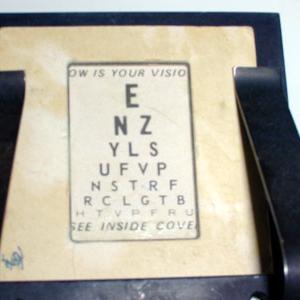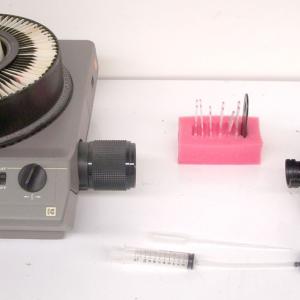College of Liberal Arts & Sciences
6J10.10 - Model of an Eye
See also 6J10.10 in Optics.
No preparation except for routine cleaning.
The Eye charts can be used to show normal vs. abnormal eye function.
The Pasco eye model has an adjustable focal length lens that is quite good for simulating near sightedness, normal focusing, and far sightedness. A camera may be placed so that it projects the images from the "retina" viewing screen to the entire class.
The round flask model shows why people who have some eye surgeries in which an air bubble is inserted have trouble seeing when looking down due to a total internal reflection effect.
- Liang Zeng, Guang Zeng, "Enhancing Student Learning of the Physics of the Human Eye in the Context of Computer Vision Syndrome During COVID-19", TPT, Vol. 62, #9, Dec. 2024, p. 779.
- Ana Gostincar Blagotinsek, "Visualizing Vision", TPT, Vol. 61, #1, Jan. 2023, p. 55.
- Zahra Asadollahi, Vola M. Andrianarijaona, "Eye Accommodation, Near Vision, and Far Vision From a Geometrical Optics Point of View", TPT, Vol. 59, #6, Sept. 2021, p. 417.
- Lisa Stinken, Stefan Heusler, and Hans-Otto Carmesin, "At the Limit: Introducing Energy with Human Senses", TPT, Vol. 54, #9, Dec. 2016, p. 552.
- David Keeports, "Fix Your Own Vision", TPT, Vol. 54, #6, Sept. 2016, p. 375.
- Giuseppe Colicchia and Hartmut Wiesner, "Looking into the Eye with a Smartphone", TPT, Vol. 53, #2, Feb. 2015, p. 106.
- Giuseppe Colicchia, Hartmut Wiesner, and Dean Zollman, "Photorefraction of the Eye", TPT, Vol. 53, #2, Feb. 2015, p. 103.
- Barbara Hoeling, "'Staying in Focus' - An Online Optics Tutorial on the Eye", TPT, Vol. 49, #2, Feb. 2011, p. 86.
- Michael Mauser, "Experiencing Light's Properties Within Your Own Eye", TPT, Vol. 49, #1, Jan. 2011, p. 19.
- Otaviano Helene, "A Simple Model of the Human Eye", TPT, Vol. 48, #2, Feb. 2010, p. 142.
- Paul Hewitt, "Hewitt's Response", TPT, Vol. 47, #5, May 2009, p. 262.
- John M. Clement, "Perspective Is Everything", TPT, Vol. 47, #5, May 2009, p. 262.
- Paul Hewitt, "Figuring Physics: Full Hemisphere", TPT, Vol. 47, #3, Mar. 2009, p. 134.
- G. Collichia, H. Wiesner, C. Waltner, and D. Zollman, "A Model of the Human Eye", TPT, Vol. 46, #9, Dec. 2008, p. 528.
- Giuseppe Colicchia and Hartmut Wiesner, "Laser Measrement of Optical Errors of the Eye", TPT, Vol. 44, #8, Nov. 2006, p. 512.
- Diane Riendeau, "Making Vision Correction More Visible", TPT, Vol. 43, #7, Oct. 2005, p. 473.
- Jim McNeill, "Reflective Dog Eyes", TPT, Vol. 43, #7, Oct. 2005, p. 405.
- Michael J. Ruiz, "Author's Response", TPT, Vol. 43, #3, May 2005, p. 260.
- Michael J. Ruiz, "Prescribing Eyeglasses for Myopia and Hyperopia", TPT, Vol. 43, #2, Feb. 2005, p. 88.
- Joe Wesney, "Photo of the Month: Doggie Eyes", TPT, Vol. 42, #2, Feb. 2004, p. 74.
- Bill Layton, "Inverted Images and Noninverted Shadows", TPT, Vol. 39, #9, Dec. 2001, p. 530.
- Julia Salinas and José Sandoval, "Geometrical Optics and Visual Perception", TPT, Vol. 39, #7, Oct. 2001, p. 420.
- D. A. Wardle, "The Time Delay in Human Vision", TPT, Vol. 36, #7, Oct. 1998, p. 442.
- Curt Gabrielson, "One Brain, Two Eyes, Three-D", TPT, Vol. 34, #1, Jan. 1996, p. 10.
- Jay S. Huebner and Terry L. Smith, "More on Twinkling", TPT, Vol. 32, #5, May 1994, p. 263.
- Jay S. Huebner and Terry L. Smith, "Why Magnification Works", TPT, Vol. 32, #2, Feb. 1994, p. 102.
- Martin Gardner, "Left - or Right - Eyed?", TPT, Vol. 30, #5, May 1992, p. 292.
- James K. Huhn, "You Can Be Myopic and Still Survive on a Desert Island!", TPT, Vol. 29, #9, Dec. 1991, p. 577.
- David R. Lapp and James E. Keenan, "Cow's Eye Dissection in the Physics Lab", TPT, Vol. 29, #9, Nov. 1991, p. 502.
- Fred Goldberg, Sharon Bendall, and Igal Galili, "Lenses, Pinholes, Screens, and the Eye", TPT, Vol. 29, #4, Apr. 1991, p. 221.
- R. D. Edge, "The Optics of the Eye Lens", TPT, Vol. 27, #5, May 1989, p. 392.
- William Blunk, "Response", TPT, Vol. 24, #9, Dec. 1986, p. 527.
- William M. Landau, M. D., "Shocks and Safety", TPT, Vol. 24, #9, Dec. 1986, p. 527.
- Ross Blauwkamp, Arlyn J. Van Ek, and Ronald Bergsten, "When is Yellow Yellow?", TPT, Vol. 24, #7, Oct. 1986, p. 419.
- James Vokac and William Blunk, "Alternating Vision", TPT, Vol. 242, #4, Apr. 1986, p. 243.
- Michael G. Ressl, "Pseudo-Telescopic Vision: The Case of the Myopic Eye", TPT, Vol. 24, #2, Feb. 1986, p. 100.
- Rodrick M. Grant, "The Red-Eye Effect", TPT, Vol. 23, #8, Nov. 1985, p. 514.
- Karl C. Mamola, "Inversion of Shadows on The Retina", TPT, Vol. 21, #5, May 1983, p. 332.
- Robert L. Lehman, "The Author Replies", TPT, Vol. 21, #3, Mar. 1983, p. 144.
- Maurice Bruce Stewart, "Shedding Light on Color", TPT, Vol. 21, #3, Mar. 1983, p. 144.
- Thomas B. Greenslade, Jr., "The Demonstration Eye", TPT, Vol. 21, #1, Jan. 1983, p. 39.
- Roy Coleman, "A Free Giveaway - An Eye Imager", TPT, Vol. 20, #7, Oct. 1982, p. 483.
- George W. Ficken, Jr., "Behind the Eye", TPT, Vol. 20, #2, Feb. 1982, p. 72.
- Haym Kruglak, "Another Look at Visual Acuity", TPT, Vol. 19, #8, Nov. 1981, p. 552.
- George Barnes, "Inversion of an Image on the Retina", TPT, Vol. 19, #7, Oct. 1981, p. 499.
- Michael J. Ruiz, "Visual Activity Revisited", TPT, Vol. 18, #8, Nov. 1980, p. 560.
- Michael J. Ruiz, "The Physics of Visual Acuity", TPT, Vol. 18, #6, Sept. 1980, p. 457.
- George W. Ficken, Jr., "Estimating Logarithmic Base of Eye's Intensity Response", TPT, Vol. 17, #2, Feb. 1979, p. 111.
- Richard Bone and John McTavish, "Cyclops - A Demonstration Model of the Human Retina", TPT, Vol. 16, #3, Mar. 1978, p. 154.
- G. D. Hoyt, "Experiment on Surface Tension and Pressure of a Balloon", TPT, Vol. 13, #6, Sept. 1975, p. 355.
- Bob Holcomb, "New Insight on Sight", TPT, Vol. 6, #9, Dec. 1968, p. 479.
- Z. V. Harvalik, "What Color Do You Really See", TPT, Vol. 5, #6, Sept. 1967, p. 274.
- Jean-Pierre Eckmann, "Broken Pencils and Moving Rulers: After an Unpublished Book by Mitchell Feigenbaum", AJP, Vol. 89, #10, Oct. 2021, p. 955.
- T. B. Smith, "Modeling Corneal Transparency", AJP, Vol. 75, #7, July 2007, p. 588.
- Glenn S. Smith, "Human Color Vision and the Unsaturated Blue Color of the Daytime Sky", AJP, Vol. 73, #7, July 2005, p. 590.
- Mark A. Heald, "Where is the 'Wien Peak'?", AJP, Vol. 71, #12, Dec. 2003, p. 1322.
- Geoff Nunes, "Comment on 'Eyesight and the Solar Wien Peak,' by James M. Overduin [Am. J. Phys. 71 (3), 216–219 (2003)]", AJP, Vol. 71, #6, June 2003, p. 519.
- James M. Overduin, "Eyesight and the Solar Wein Peak", AJP, Vol. 71, #3, Mar. 2003, p. 216.
- H. A. Doyle, "Demonstrations of Inverted Images on the Retina", AJP, Vol. 60, #5, May 1992, p. 474.
- Ann Jervice Sefton, "Use of the Reduced Eye in Life-Science Labs", AJP, Vol. 48, #6, June 1980, p. 494.
- C. S. MacLatchy, "The Diameter of the Fovea - A Short Exercise for the Life-Science Physics Lab", AJP, Vol. 46, #10, Oct. 1978, p. 1076.
- C. S. MacLatchy, "Radius of Curvature of a Cornea - an Experiment for the Life-Science Physics Lab", AJP, Vol. 46, #6, June 1978, p. 615.
- Antti Arell and Samuli Kolari, "Experiments on a Model Eye", AJP, Vol. 46, #6, June 1978, p. 613.
- Theodore J. Wang, "Visual Response of the Human Eye to X Radiation", AJP, Vol. 35, #8, Aug. 1967, p. 779.
- Charles Day, "A Biologically Inspired Artificial Eye", Physics Today, Vol. 69, #5, May 2016, p. 20.
- Stephen G. Benka, "Theory Meets Experiment In The Blink Of An Eye", Physics Today, Vol. 65, #7, July 2012, p. 17.
- Charles Day, "Study Tracks the Changes in a Vision Protein as Fish Evolved", Physics Today, Vol. 61, #10, Oct. 2008, p. 20.
- Neil Ribe and Friedrich Steinle, "Exploratory Experimentation: Goethe, Land, and Color Theory", Physics Today, Vol. 55, #7, July 2002, p. 43.
- Gunnar Johansson, "Visual Motion Perception", Scientific American, Vol. 232, #6, June 1975, p. 76.
- Richard Held, "Eye Movements and Visual Perceptions", Scientific American, May 1974, p. 113.
- Richard Held, "Form Analysis", Scientific American, May 1974.
- Richard Held, "The Processes of Vision", Scientific American, May 1974, p. 4.
- David Noton and Lawrence Stark, "Eye Movements and Visual Perception", Scientific American, Vol. 224, #6, June 1971, p. 34.
- Adolf Cortel, "Simple Experiments on the Physics of Vision: The Retina", Physics Education, Vol. 40, #4, July 2005, p. 325.
- Béla Szomi Kralj, "DIY Enables Affordable Lessons in Light", Physics Education, Vol. 40, #4, July 2005, p. 320.
- Corinne Iozzio, "Contact Lens Sees Eye Disease Before It Strikes", Popular Science, Vol. 287, #1, Jan. 2015, p. 35.
- Neel V. Patel, "Gamers Reveal Inner Workings of the Eye", Popular Science, Vol. 286, #9, Sept. 2014, p. 29.
- G. D. Freier and F. J. Anderson, "Og-8", A Demonstration Handbook for Physics.
- Wallace A. Hilton, "G-7", Experiments in Optical Physics, p. 14.
- Curt Suplee, "Seeing and Believing", Everyday Science Explained, National Geographic, p. 246 - 247.
- "Nearsighted Hoops", 50 Fun Experiments for the Mad Scientist in You, National Geographic Kids, p. 66.
- John Henry Pepper, "The Human Eye", Cyclopadic Science Simplified, p. 64.
- Bill Franklin, "Understanding Color Vision", Teaching about Color & Color Vision, 1996, p. 2A-1.
- Pat Murphy, Ellen Macaulay, and the staff of the Exploratorium, "Eye Wars", Exploratopia, p. 15.
- Pat Murphy, Ellen Macaulay, and the staff of the Exploratorium, "Drawing Your Eye", Exploratopia, p. 2.
- Martin Gardner, "Left- or Right-Eyed?", Science Tricks, p. 73.
- "The Eyes Have It", Uncle John's Bathroom Reader, p. 255.
- Paul Doherty and Don Rathjen, "Pupil", The Cheshire Cat, p. 88.
- Vicki Cobb and Kathy Darling, "Missing the Point", Bet You Can't!, p. 103.
- Vicki Cobb and Kathy Darling, "Keeping the Lids On", Bet You Can!, p. 14.
- "How the Eye Works with Light", The Boy Scientist, p. 181.
- "How Light Waves Travel", The Boy Scientist, p. 180.
- Jearl Walker, "7.44, Purkinje's Blue Arcs", The Flying Circus of Physics Ed. 2, p. 322.
- Jearl Walker, "7.45, Maxwell's Spot", The Flying Circus of Physics Ed. 2, p. 322.
- Jearl Walker, "7.43, Depth in Red and Blue Signs", The Flying Circus of Physics Ed. 2, p. 321.
- Jearl Walker, "7.42, Fish Lens", The Flying Circus of Physics Ed. 2, p. 320.
- Jearl Walker, "7.36, A Stargazer's Eye Sweep", The Flying Circus of Physics Ed. 2, p. 318.
- Jearl Walker, "7.34, Finger Colors", The Flying Circus of Physics Ed. 2, p. 318.
- Jearl Walker, "7.26, An Upside-Down World", The Flying Circus of Physics Ed. 2, p. 315.
- Jearl Walker, "7.25, Mach Bands", The Flying Circus of Physics Ed. 2, p. 315.
- Jearl Walker, "7.17, Reflecting Eyes", The Flying Circus of Physics Ed. 2, p. 312.
- Jearl Walker, "7.9, Keeping Your Eye on the Baseball", The Flying Circus of Physics Ed. 2, p. 244.
- Jearl Walker, "7.4, Gray Networks in the Morning, Dashing Specks in the Daylight", The Flying Circus of Physics Ed. 2, p. 306.
- Harvard Instructional Physics Labs, "Geometrical Optics; Refraction and Dispersion", https://sites.fas.harvard.edu/~scphys/
- M. Minnaert, "Chapter 6, "The Eye", Nature of Light and Colour in the Open Air, p. 90 - 107.
- Janice VanCleave, "Determine Which Light Color Has the Least Effect on Night Vision", Super Science Challenges, p. 17.
- Janice VanCleave, "Seeing is Believing", The Human Body for Every Kid, p. 85 - 91.
- C. Harvey Palmer, "Experiment A18: Some Properties of the Human Eye", Optics - Experiments and Demonstrations, John Hopkins Press, 1962.
- T. D. Rossing and C. J. Chiaverina, "3, Color-Sensitive Zones On The Retina", Light Science, Physics and Visual Arts, p. 201.
- T. D. Rossing and C. J. Chiaverina, "8.2, Photoreceptors In The Eye", Light Science, Physics and Visual Arts, p. 176.
- T. D. Rossing and C. J. Chiaverina, "Color Vision", Light Science, Physics and Visual Arts, p. 173.
- T. D. Rossing and C. J. Chiaverina, "6, Resolution of The Eye", Light Science, Physics and Visual Arts, p. 125.
- T. D. Rossing and C. J. Chiaverina, "4.9, The Human Eye", Light Science, Physics and Visual Arts, p. 93.
- Brian Jones and Matt Fackelman, "Eyeball Viewer", Don't Forget the Duct Tape, p. 45 - 48.
- "The Optics of the Eye", Selective Experiments in Physics, CENCO, 1962.
- W. Bolton, "2. The Sensitivity of the Eye", Book 2 - Waves and Particles, Physics Experiments and Projects, 1968, p. 75 - 76.
- Curt Suplee, "Seeing and Believing", Everyday Science Explained, National Geographic, p. 246 - 247.
- Don Herbert and Hy Ruchlis, "Your Senses", Mr. Wizard's 400 Experiments in Science, p. 9 - 12.
- UNESCO, "B. Your Senses", 700 Science Experiments for Everyone, p. 207 - 209.
- Sara Stein, "What Meets The Eye", The Science Book, p. 186.
- Sara Stein, "Forming Images", The Science Book, p. 188.
- Sara Stein, "Visual Purple", The Science Book, p. 199.
- Tik L. Liem, "Are You Left- Or Right-Sighted? (II)", Invitations to Science Inquiry - Supplement to 1st and 2nd Ed. p. 150.
- Julius Sumner Miller, Q201 & A201, Millergrams II – Some More Enchanting Questions for Enquiring Minds, p. 58 & 108.
- Joseph Frick, "#172 - The Eye", Physical Technics: Or Practical Instructions for Making Experiments in Physics and the Construction of Physical Apparatus with the Most Limmited Means, p. 201.
Disclaimer: These demonstrations are provided only for illustrative use by persons affiliated with The University of Iowa and only under the direction of a trained instructor or physicist. The University of Iowa is not responsible for demonstrations performed by those using their own equipment or who choose to use this reference material for their own purpose. The demonstrations included here are within the public domain and can be found in materials contained in libraries, bookstores, and through electronic sources. Performing all or any portion of any of these demonstrations, with or without revisions not depicted here entails inherent risks. These risks include, without limitation, bodily injury (and possibly death), including risks to health that may be temporary or permanent and that may exacerbate a pre-existing medical condition; and property loss or damage. Anyone performing any part of these demonstrations, even with revisions, knowingly and voluntarily assumes all risks associated with them.




